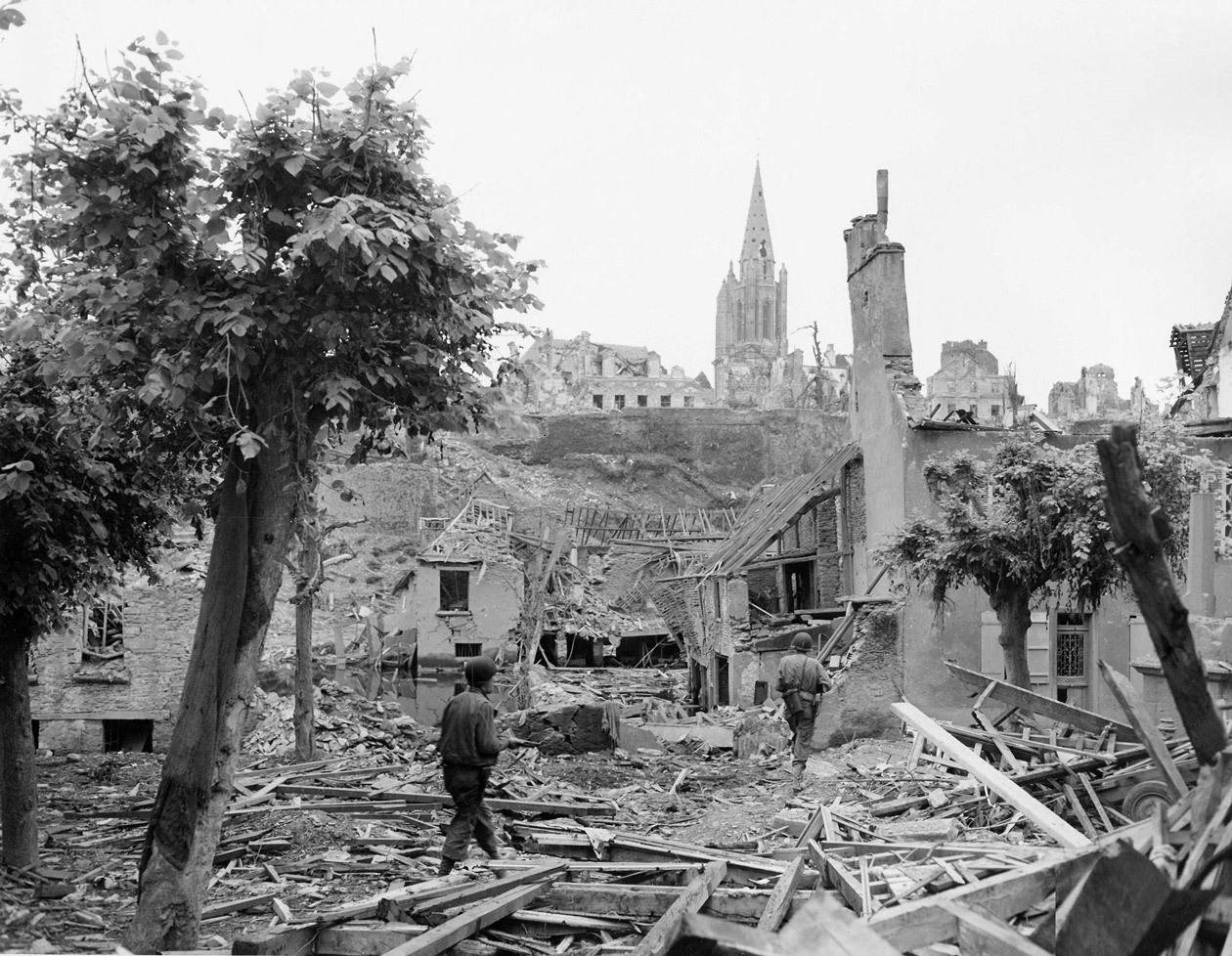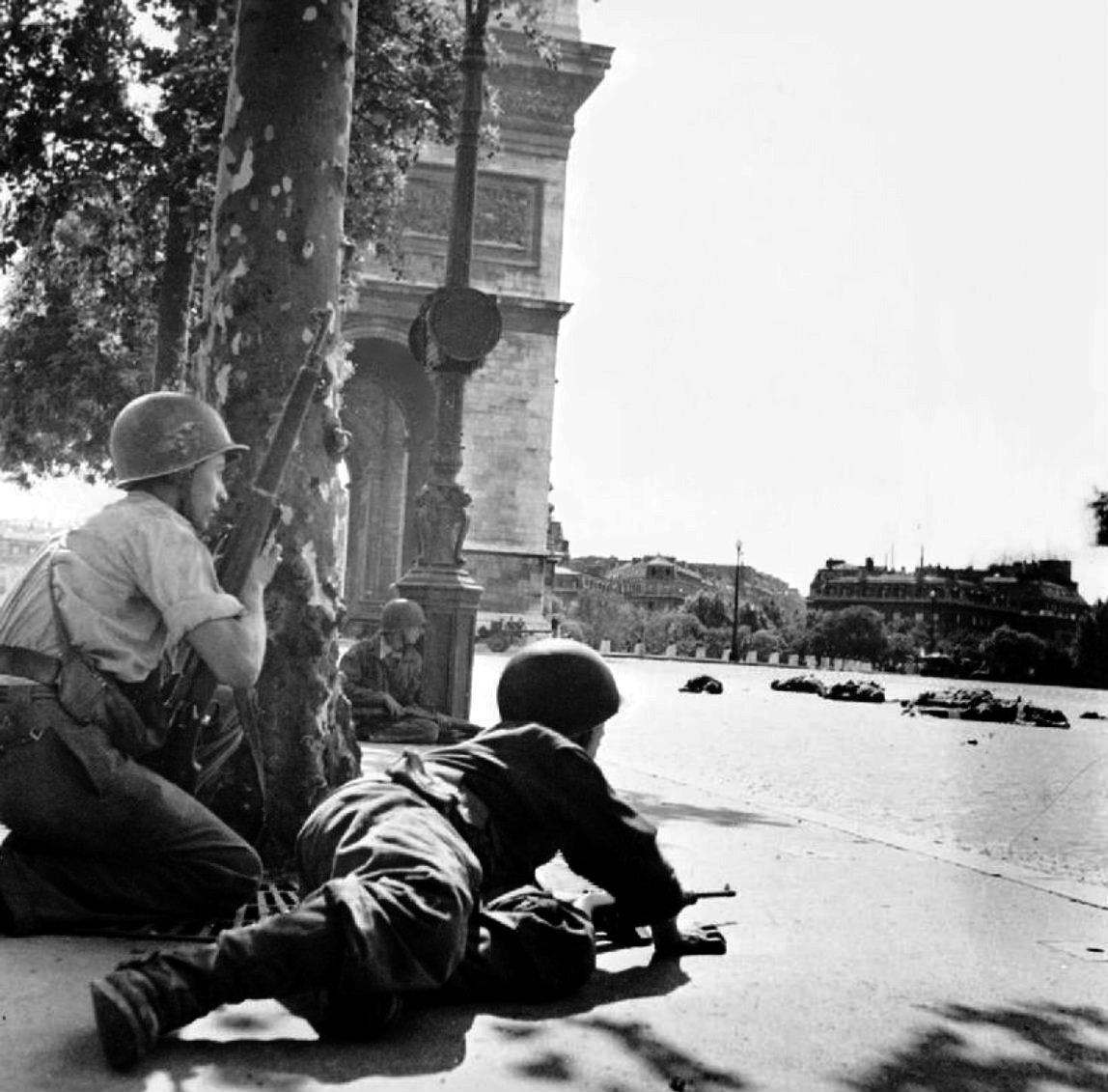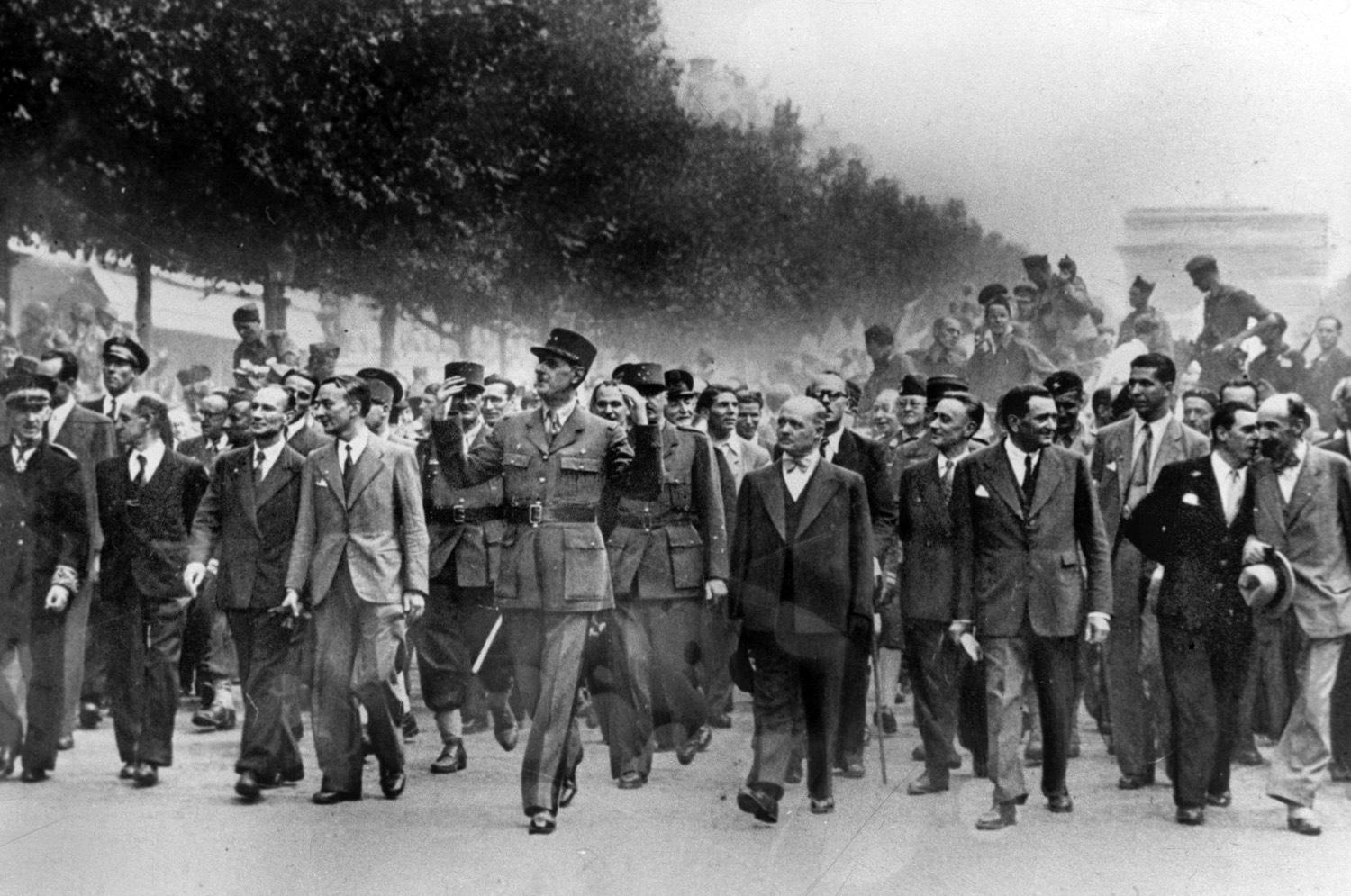The Liberation of Paris
Posted on
On June 5, 1944, five minutes before midnight, a broadcast from Radio London began with a familiar introduction: “Here is London. The French speak to the French. Before we begin, please listen to some personal messages.” French Résistance members huddled around their illegal radio receivers and listened attentively. The broadcast continued: “Les sanglots longs des violons de l’automne blessent mon coeur d’une langueur monotone.”

“We knew that something would happen soon, because the train from Paris didn’t reach Caen – the lines had been sabotaged. That evening I heard two messages – ‘the dice are on the table’, meaning we should sabotage railway lines; and ‘it’s hot in Suez’, meaning we should attack telephone lines.”
— André Heinz, member of the French Résistance
This last message was their final cue. The Allied invasion of France would begin within 24 hours.
“Full Victory — Nothing Else”
Operation Overlord was set to be the largest seaborne invasion in history. The objective was to open a new front in western Europe from which the Americans and the British could drive straight to Berlin. The Allies had planned every minute detail of the invasion in utmost secrecy, and had used all available means to mislead the Germans about their true intentions, including fake armies, double agents and false radio traffic.

General Eisenhower explained the stakes in no uncertain terms: “This operation is not being planned with any alternatives. This operation is planned as a victory, and that’s the way it’s going to be. We’re going down there, and we’re throwing everything we have into it, and we’re going to make it a success.”

At dawn on June 6 1944, several thousand boats carrying millions of tons of men an matériel set across the English Channel for the invasion of Northern France. In the air, thousands of fighters and bombers flying wingtip to wingtip filled the sky, headed towards their objectives further inland.
After a devastating bombardment, the first waves of American, British, and Canadian soldiers stormed the beaches of northern France under vicious fire. Private First Class Earl Chellis from the 1st infantry division was among the first to land at Omaha beach:
“Every time you fired your gun, machine guns would fire back at you. Men were still coming in. It was getting very crowded on the beach. Bodies of the dead and wounded kept washing up on the shore. They were coming in and out on the tide. The water turned red from all the blood.”

For the Germans, the surprise was total. The elaborate deception campaign led them to believe the landings would take place in the Pas-de-Calais. The ruse was so successful that the high command expected a second landing in eastern France for weeks as thousands of Allied troops poured in from Normandy.
However, Hitler’s undermanned Atlantic wall could not hold against the waves of infantrymen crashing against them. By noon, the last strongpoints were overrun, and endless streams of soldiers, jeeps, trucks and tanks began moving inland. Operation Overlord was a success.

The martyrdom of Normandy
At first, the French civilians were reluctant to welcome their liberators. While many of them feared reprisals from the Germans, most were simply taken aback by the violence of the fighting. The devastation of Allied bombers, artillery and naval gunfire was a stark contrast to the relatively peaceful German occupation.

Towns like Saint-Lô, Cherbourg and Caen were levelled by American and British artillery, with some 15 000 civilians killed during the preparatory bombing alone. “We sure liberated the hell out of this place”, commented an American soldier upon seeing Saint-Lô’s ruins.


Once hopes of repelling the invasion evaporated, the Germans faced increasingly daring attacks from the French Résistance. The SS was absolutely ruthless in its reprisals. In Oradour-sur-Glane, a Waffen-SS company rounded up and gunned down 642 French civilians, of which 205 were children.
However, the SS brutality did little to stop the Allied steamroller. Soon enough, Saint-Lô, Bayeux, Cherbourg, Caen and many other French cities were liberated. In Cherbourg, the bells pealed madly to celebrate the liberation. Jubilant citizens gathered at the Place de la République to welcome the columns of American soldiers.



Collapse and breakout
On July 25, the Americans launched Operation Cobra. While the British pinned down German forces in the east, they would punch through the weakly defended west flank and push as far as they could.
Despite offering a dogged resistance, the German forces were helpless against the formidable Allied war machine. Germany was already fighting on two other fronts while thousands of British and American bombers pummelled its cities on a weekly basis. The vastly outnumbered defenders could not scramble sufficient forces to simultaneously hold Caen against the British and Brittany against the Americans.
By the mid-August, the entire German position in Normandy was on the verge of collapse. The 5th and 7th Army were nearly surrounded. Under constant attack from Allied fighter-bombers, battle-weary Germans hastily retreated eastwards riding any vehicle they could find.

“This is an opportunity that comes to a commander not more than once in a century. We’re about to destroy an entire hostile army and go all the way from here to the German border”
— General Bradley, U.S. Army
Nonetheless, many among their ranks - especially the Hitler Youth - fought fanatically, sometimes to annihilation. Even after capture, some of them refused care to “die for the Führer”. The 12th SS Hitler Youth in particular sustained disproportionate casualties in Normandy. However, their sacrifice allowed some 25 000 Germans to break out escape encirclement.

Some others surrendered as soon as they had the chance. Eastern European conscripts often shot their German officers in the back as soon as the fighting began so they could surrender and sometimes even fight for the Allies. Polish soldiers fighting alongside the British and the Canadians were surprised to find compatriots among the prisoners.

A Korean soldier named Yang Kyoungjong was also captured shortly after D-Day. He had been conscripted in the Imperial Japanese army, then captured by the Soviet Red Army, then by the German Wehrmacht, and finally by the U.S. Army.

By mid-August the Allies were only a few miles from Paris. A secondary landing in southern France sent the rest of the German forces in a chaotic retreat.
Leclerc’s army
Four years earlier, Philippe Leclerc and his 4e Division d’Infanterie were encircled by the Germans. Leclerc attempted to make his way back to French lines disguised as a French refugee, but was caught and brought back to a German command post. As a fluent German speaker, he managed to convince his captors that he was exempt of military service, and he was let go.
Upon his return to French lines, he was ordered to join a scratch company, but was wounded two weeks later. He was captured a second time when his hospital was overrun by the Germans, but escaped again by jumping through a window.
After the fall of France, he escaped to Britain to join Général de Gaulle’s Free French forces, where he would lead the 2e Division Blindée through the battle of Normandy, alongside the American 3rd army.

By mid-August, his division had reached the outskirts of Paris.
The Paris uprising
On August 8, Dietrich von Choltitz was appointed Governor of Paris. Facing the inevitable capture of the French capital, Hitler gave him clear orders: “The city must not fall into the enemy’s hand except lying in complete rubble”. Von Choltitz ordered for bridges and monuments to be wired for demolition. The Notre Dame cathedral alone was laced with three tons of explosives.
However, the string of Allied victories did not escape the Parisians, who knew the Germans were on the run. On August 15, upon hearing of a secondary Allied landing in southern France, the Paris Métro employees, the Gendarmerie and the police went on strike. The next day, this act of defiance snowballed into a general strike.
Meanwhile, columns of retreating German tanks, halftracks, trucks and cars streamed down the Champs Élysées. Daring Frenchmen taunted them from the balconies, belting out La Marseillaise and giving them the V sign.
On the 19th, the Résistance learned that the Allies were only a few miles from Paris and the general strike escalated into an armed uprising. Parisians - men, women and children alike - took up arms and fired at the occupiers from apartment windows and makeshift barricades.
“The people were like ants - tens of thousands of them. Some of the barricades were real masterpieces, built by craftsmen and strong enough to stop a tank. Others would have just collapsed, but the German did not know which was which.”
— Maurice Kriegel-Valrimont, French Résistance


After two days of fighting, the Germans occupied most of the strategic positions, while the Resistance held the rest of the city. Armed partisans zoomed up and down the boulevards in commandeered Citroëns, cheered by civilians perched at their windows. German soldiers who once freely roamed from café to café now ran from cover to cover.
“In Paris we had one great advantage - which was a tradition of popular uprising. There was the revolution of course in 1789, but after that 1830, 1848, above all the Commune in 1870. There was a body of doctrine. We knew how to do it.”
— Maurice Kriegel-Valrimont, French Résistance

The days of the German garrison were numbered, but the insurgents lacked the heavy weaponry to assault the remaining pockets of resistance. With both sides in a stalemate, a temporary ceasefire was negotiated, but many résistants happily ignored it.
Paris libérée
Little did the Parisians know that the Allies intended to bypass Paris and rush for the German border. Paris held little strategic value to Eisenhower, and he wanted to avoid diverting supplies and troops to liberate it.
However, Général Leclerc feared that the uprising in Paris would be brutally crushed as had happened in Warsaw. He persuaded Eisenhower to free his 2e Division Blindée so he could relieve the Résistance and kick the Germans out of the French capital.
The Free French forces entered the suburbs of Paris on August 24. Parisians supported by Free French tanks cleared pockets of resistance one by one. Every few blocks, the silence was broken by a salvo of small arms, and the fighting resumed until the enemy stopped returning fire.

By the next morning, the Free French had reached the Notre Dame cathedral.
“The vehicles just ahead of us rolled into the square and parked, and we parked the jeep with them. Kokoska switched off the motor. We looked up at the lovely towers of Notre Dame, and someone said, ‘Well, that’s that. The fight is all over now.’ As he finished speaking, the air crackled into life with bullets, hissing and whining all over the square. The French light tanks began firing over our heads at some Germans across the Seine. Germans were also shooting from Notre Dame and from nearby houses. The shooting sputtered, then died down, and finally burst out with new fury before it ceased. The air was strangely quiet. I could see the sun glint on the white marks where the bullets had struck Norte Dame.”
— NBC correspondent John Mac Vane



According to popular accounts, an enraged Hitler phoned von Choltitz, and inquired “is Paris burning?” The führer wanted to raze the city and have its garrison fight to the last bullet. However, von Choltitz was well aware that the orders came from an increasingly senile man.
On August 25, von Choltitz surrendered Paris to Général Leclerc. None of the explosives had been detonated, and the city of light was left intact.



As soon as the surrender was announced, thousands of jubilant Parisians stormed the streets. The air was filled with chants, music and all sorts of hymns to victory.



The liberation also unfurled a wave of violent reprisals across the city. Buses that carried German prisoners were stopped by angry mobs who would drag out the passengers and beat them, sometimes to death. Collaborators rarely fared better. French prostitutes who had slept with the occupiers were publicly shamed by shaving their head in the streets, and many of them were violently beaten. Many more were lynched in the upcoming weeks.

De Gaulle enters Paris
The next day, millions of them gathered to welcome the triumphal 2e Division Blindée. The occasional sniper would often disrupt the celebrations, but the crowd would erupt in cheers as soon as they were dealt with. The finest wine was enjoyed straight from the bottle, none of it too good to survive the grandiose occasion.




From the City Hall, Général de Gaulle addressed the Parisians sentences that would make history:
“Paris! Paris outraged! Paris broken! Paris martyred! But Paris liberated! Liberated by itself, liberated by its people with the help of the French armies, with the support and the help of all France, of the France that fights, of the only France, of the real France, of the eternal France!”
At long last, Paris was free! It was only a matter of time before the Germans would be kicked out of France entirely. Soon enough, the war would end.
A few last words
This article was written over three months, and required extensive research. I have represented widely accepted facts to the best of my abilities, using renowned historians as my primary sources whenever possible. The pictures are all accurately dated and caption.
However, I had to deliberately omitted details to boil a complex story down to a short, interesting article. If you would like to read more about it, I urge you to find a copy of Anthony Beevor’s wonderful book on the liberation of France. It addresses a lot more than I feel qualified to write about.